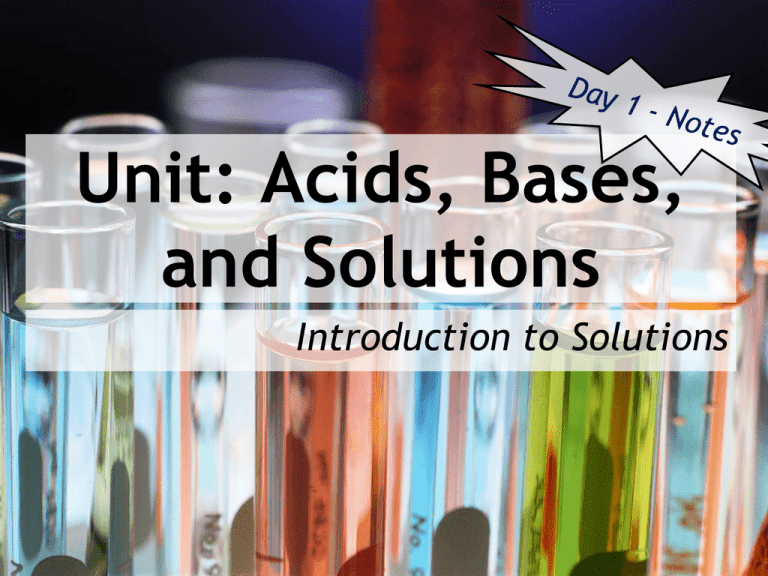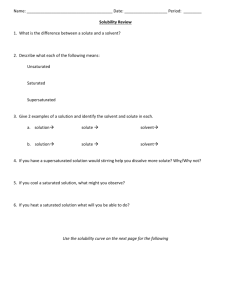Day One Solution Notes
advertisement

Unit: Acids, Bases, and Solutions Introduction to Solutions After today you will be able to… • Explain the differences between the three different types of solutions • Describe how to make a supersaturated solution • Describe how to increase the rate of dissolving A solution is a homogeneous mixture. The components are not chemically combined and retain their original properties. Example: Sugar water – still tastes sweet Solutions A solution is made up of a solute and solvent. •Solute: a dissolved substance •Solvent: the most abundant component of a solution, what does the dissolving Water is called the “universal solvent” because it has the ability to dissolve so many substances. Solutions Recall, aqueous is a solution where water is the solvent. Example: + NaCl(aq) Na + Cl Solubility The maximum amount of solute dissolved in a particular solvent at a specific temperature. •Saturated: No more solute can dissolve •Unsaturated: More solute can dissolve •Supersaturated: More solute is dissolved than theoretically possible To make a supersaturated solution: 1. Add more solute than solubility allows 2. Heat the solution up 3. Slowly cool it down This is a temporary and unstable state for a solution! Factors that affect solubility: 1. Temperature: most solid substances have higher solubility as temperature increases • All gas solutes have lower solubility as temperature increases 2. Pressure: only affects gas solutes • All gas solutes have higher solubility as pressure increases Solubility Curves For Solid Solutes: For Gas Solutes: Rate of dissolving: How fast a solute dissolves in a solvent – not to be confused with how much. Rate can be increased by: 1. Increasing temperature- There is more kinetic energy available to meet the activation energy (energy available for dissolving) 2. Stirring- Increases the interaction between solute and solvent 3. Powdering- Increase surface area of the solute which increases the interaction between solute and solvent Liquid-Liquid Solutions • Miscible: two liquids which uniformly mix together (ex: milk and water) • Immiscible: two liquids which will not mix, forms two layers (ex: oil and water) As a general rule: “Like dissolves like” Non-polar + non-polar = miscible Polar + Polar = miscible Non-polar + Polar = immiscible Concentration Indicates the amount of solute dissolved in a given quantity of solvent. • Dilute: a small amount of solute • Concentrated: a large amount of solute Questions? Begin WS1





